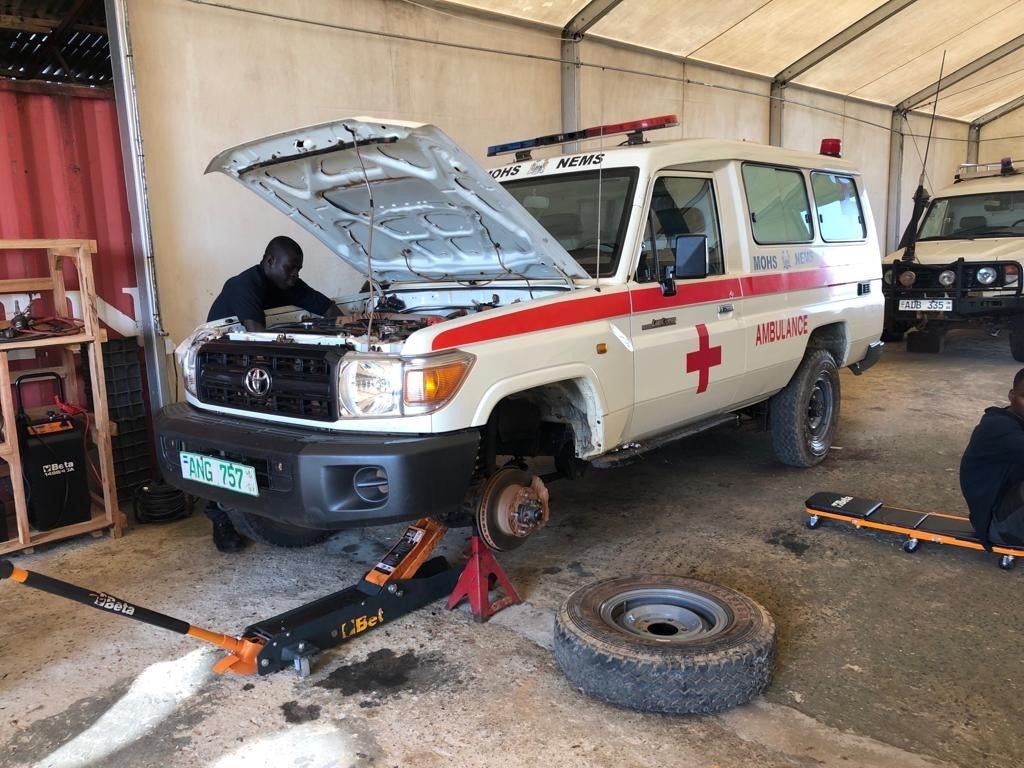 NEMS ambulances at Hasting, Western Area Rural, Sierra Leone
NEMS ambulances at Hasting, Western Area Rural, Sierra Leone
What can be accomplished in just one minute? You can reply to an email, eat an apple or do fifty jumping jacks. With the right training, one can save a newborn’s life.
In February 2019, when Mrs. KM from Tonkolili District of Sierra Leone went into labor at home, community leaders called the National Emergency Medical Service (NEMS) operations center for an ambulance, which arrived within minutes to pick up Mrs. KM.
During the ride to the hospital, the paramedic carefully assessed the expectant mother and explained that she might be expecting twins and could possibly deliver them in the ambulance. Thanks to the paramedic’s expertise and calm support, the twins – a boy and a girl, were successfully delivered. Later in the hospital, out of gratitude to their ambulance team, the new parents named the twins NEMS and CUAMM (the NGO that manages NEMs).
First-of-its-kind emergency system in Sierra Leone
NEMS provides aid and medical assistance in and out of hospital with personnel trained in rescue, stabilization and transportation of traumatic and medical emergencies. Not only is this program the first national pre-hospital emergency medical system in Sierra Leone, it is just the fourth of its kind on the African subcontinent. It also effectively utilizes ambulances donated from around the world during the 2014-16 Ebola crisis, when they had previously sat unused for many months. Additionally, it has created real economic impact by providing job opportunities for health workers who had previously been working as volunteers.
Wheels in motion
With funding, technical support and advisory services from the World Bank, NEMS began operations in October 2018. World Bank task teams were involved from the beginning, providing assistance on the system’s setup and advising on the overall program.
By the end of January 2020, NEMS received almost 32,000 emergency calls, made over 30,000 missions and handled nearly 27,000 referrals. Eighty ambulances were placed all over the country, with 4-8 vehicles in each district depending on its population. They provide 24/7 medical support, and so far, have travelled more than 2.2 million kilometers in total.
Equipped for different emergencies
Sierra Leone has one of the world’s worst maternal-mortality ratios (1,120 deaths per 100,000 live births) according to the WHO Global Health Observatory. Consequently NEMS has made obstetric emergencies a priority and more than half of their missions are obstetric in nature. However, besides timely and comprehensive maternal infant care, as well as pediatric referrals, NEMS also provides emergency response transportation for other types of incidents requiring emergency medical care. Pediatric complaints made up 24% of overall missions in December 2019, and other types of complaints represented 22% of missions, with loss of consciousness, road accidents, abdominal pain and seizures being the leading causes.
Maintenance for performance
NEMS also developed special training programs for drivers, paramedics, and operation center (OC) staff. Over 600 drivers and 600 paramedics received training before the launch of NEMS and 900 staff across all the districts have received refresher training from July to September 2019. Moreover, over 400 drivers received advanced 4-wheel driving training. More than 40 NEMS OC operators were trained on call-taking, triage, and dispatch processes and over 30 operators received refresher training focused on communications skills a year after their initial training.
Poor road conditions in Sierra Leone necessitate regular maintenance of the ambulances. According to NEMS protocol, check-ups must be performed after every 5000 miles traveled. Therefore, NEMS has set up three fully equipped main workshops and has a mobile team of mechanics ready to travel across the country and provide maintenance and repairs.
Rocky road ahead?
One of the challenges faced by NEMS is that it is currently limited to health care professionals referring patients from clinics to hospitals. It is not yet open to the public. Recent discussions have considered a pilot program to open NEMS to the public. However, concerns remain regarding increased costs and patient volume in hospitals.
Another major challenge of NEMS is financial constraints -- annual operation costs amount to USD$ 5-6 million. Considering that current World Bank funding (a grant of USD$13 million) for NEMS will expire in March 2020, developing a long-term plan for the GoSL to take over funding is imperative. Fortunately, the GoSL has committed USD$ 5 million to NEMS, most of which will go towards salaries for nearly 1,000 employees. This allocation of funding has shown the GoSL’s confidence in NEMS’ utility and ability to improve emergency response times, as well as enhance the quality of the emergency healthcare service’s delivery.
Though it still has a long way to go, NEMS in Sierra Leone will be a significant step toward a strong national healthcare system that Sierra Leoneans can rely on.




Join the Conversation